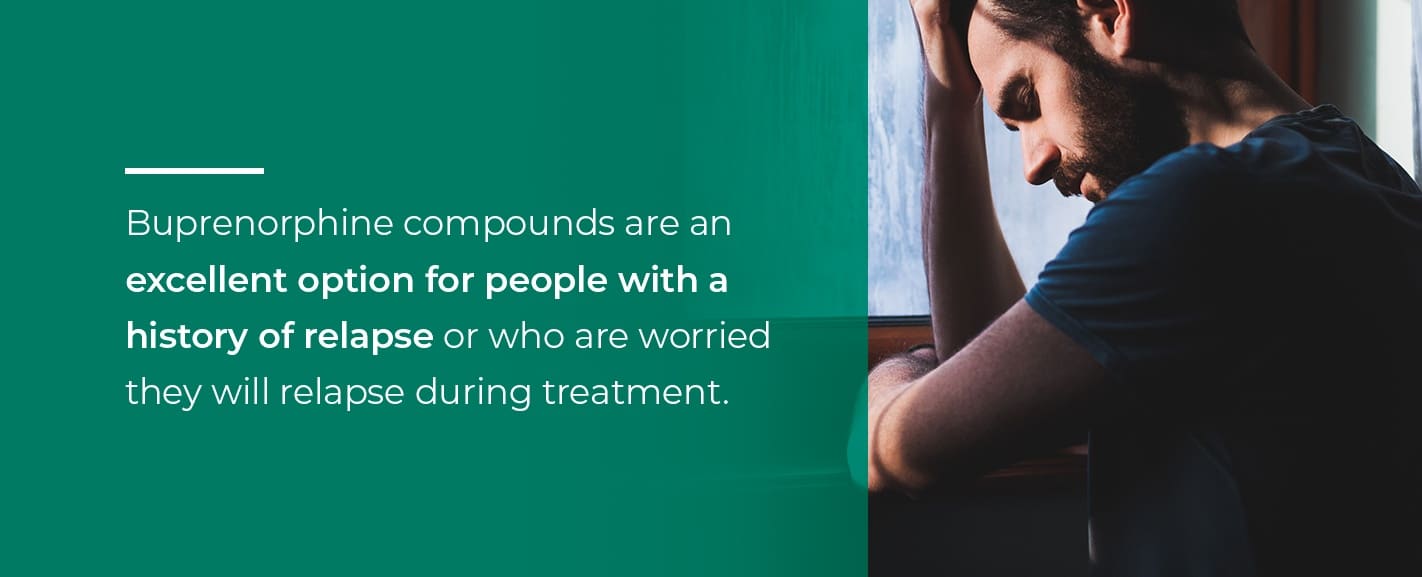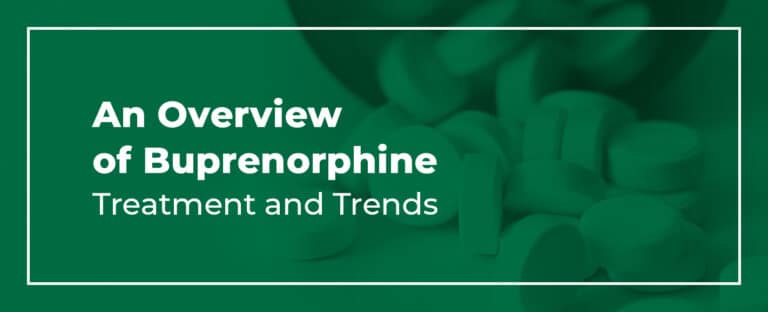Of the many treatment options available for addiction to opioids, buprenorphine and buprenorphine compounds with naloxone are some of the most effective options. These medications were approved by the Food and Drug Administration (FDA) for clinical use in the treatment of opioid use disorder (OUD) in 2002, and have been proven effective for thousands of people struggling to overcome addiction.
Buprenorphine and its compounds such as Suboxone® are used in medication-assisted treatment (MAT), a form of addiction treatment that is more effective than either medication or behavioral intervention alone. Here’s what you need to know about this treatment medication and how it works.
What Is Buprenorphine?
Buprenorphine is what’s known as a partial opioid agonist, which means it binds to opioid receptors in the brain but does not activate the receptors as much as a full agonist like methadone would. Buprenorphine produces enough of an opioid effect to prevent the onset of withdrawal symptoms, but because the receptors aren’t fully engaged, the medication has a “ceiling effect.”
This ceiling effect means that there is a point where buprenorphine’s ability to produce any sort of euphoric effects levels off no matter how much more of the medication a person takes. The ceiling effect acts as a deterrent to abuse, which was one of the reasons the medication was developed. The benefits of buprenorphine’s ceiling effect include:
- Less ability to achieve euphoria
- Less physical dependence
- Lower potential for misuse
- Mild withdrawal profile upon cessation
Buprenorphine at appropriate prescribed doses:
- Suppresses painful symptoms of opioid withdrawal
- Decreases drug cravings for opioids
- Reduces illicit use of opioids
- Blocks effects produced by other opioids
Overall, buprenorphine makes it easier for people to stay in treatment and remain engaged throughout their program.

What Are Alternatives to Buprenorphine?
Buprenorphine is often prescribed by itself, but the FDA has also approved some other buprenorphine products including:
- Suboxone® (buprenorphine and naloxone) film
- Zubsolv® (buprenorphine and naloxone) sublingual tablets
Buprenorphine compounds like those above use naloxone in their formulations. Naloxone is more commonly known as Narcan®. This rescue medication is used to stop opioid overdoses as they happen, by blocking opioids from producing activity at the corresponding receptors in the brain. It triggers an uncomfortable withdrawal effect.
When taken according to a doctor’s instructions and dissolved in the mouth, the naloxone in a buprenorphine compound medication does not trigger any withdrawal effects. If a buprenorphine compound medication is dissolved and injected into the bloodstream, the individual will begin experiencing precipitated withdrawal symptoms almost immediately. Moreover, the person will not be able to reverse the withdrawal symptoms by taking another opioid, as the naloxone has a very high affinity for opioid receptors and can’t be “kicked off” by other opioids.
Buprenorphine compounds are an excellent option for people with a history of relapse or who are worried they will relapse during treatment, thanks to the deterrent feature of naloxone.
How Does Buprenorphine Compare to Methadone?
As opposed to buprenorphine, methadone is a full opioid agonist. It binds fully to opioid receptors and produces analgesic effects. Methadone continues to produce activity at the receptors until all receptors are completely activated, or until the medication produces its maximum effect.
Buprenorphine’s plateau effect means that even with increases in dosage, there is no increase in the opioid effect after a certain, moderate dose. For people who aren’t dependent on opioids, it is difficult or impossible to distinguish the effects of the partial agonist from the full agonist, but people who are dependent on very high amounts of opioids may not be able to reach stability on buprenorphine. Methadone is sometimes a more appropriate medication for those who are addicted to highly concentrated opioids.
One key difference in methadone vs. buprenorphine for opioid addictions is that methadone must be taken every day under supervision at a methadone clinic. Buprenorphine, on the other hand, is an office-based opioid treatment program (OBOT) that can be taken every other day once a patient has been stabilized. Buprenorphine can be prescribed and picked up from a pharmacy like any other medication, and patients in a buprenorphine MAT program usually only have to see the physician two or three times a week rather than attending a clinic each day.

How Long Does Buprenorphine Block Opiates?
Buprenorphine blocks opiates for longer than methadone, up to three days. This longer window of blocking is due to buprenorphine’s status as a partial agonist. It doesn’t create a perfectly aligned fit, so it occupies all the receptors without producing all of the effects.
Buprenorphine’s high affinity for opioid receptors stops full opioid agonists from binding the receptors. So if a person uses opioids while on buprenorphine, their ability to experience additional effects like euphoria is greatly diminished. Although buprenorphine can block opioids for up to three days, doctors still recommend that patients take a dose every day or possibly every other day.
Factors such as age, height, weight and history of opioid abuse can affect the length of buprenorphine’s blocking effects, so taking the medication daily is recommended at least until the individual stabilizes.
Popularity of Buprenorphine
As a medication introduced within the past two decades, buprenorphine still suffers from underutilization across the country. This is partially due to a lack of physicians qualified to prescribe the medication. Still, buprenorphine use in MAT has greatly expanded since its introduction in 2002.
In 2003, only 11% of opioid treatment facilities offered buprenorphine, which increased to 58% of opioid treatment programs in 2015. Among facilities that are not exclusively opioid treatment programs, only 5% offered buprenorphine services in 2003. That percentage increased to 21% by 2015.
The number of individuals in buprenorphine treatment has greatly increased as well. In 2004, only 727 people received buprenorphine treatment at opioid abuse treatment facilities and 1,670 received it at non-opioid treatment facilities. In 2015, opioid treatment facilities gave buprenorphine to more than 21,000 individuals, and non-opioid treatment facilities prescribed it to nearly 54,500 people.
Benefit From Buprenorphine With MedMark
Opioid addiction is a serious, chronic condition that deserves the most effective treatment available. MedMark Treatment Centers can help treat prescription painkiller and heroin addiction, as well as dependence on any other opioid drug. Our many programs across the U.S. offer methadone maintenance treatment, and select programs offer buprenorphine for opioid use disorder. Our individualized treatment plans all include the substance abuse counseling necessary to succeed in recovery.
To find out more about our opioid addiction treatment options, visit our contact page. You can also get in touch by calling (866) 840-6658. Don’t wait for recovery to find you start your journey today.

